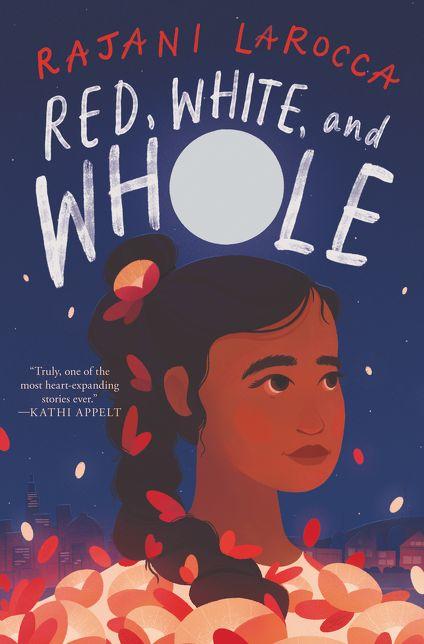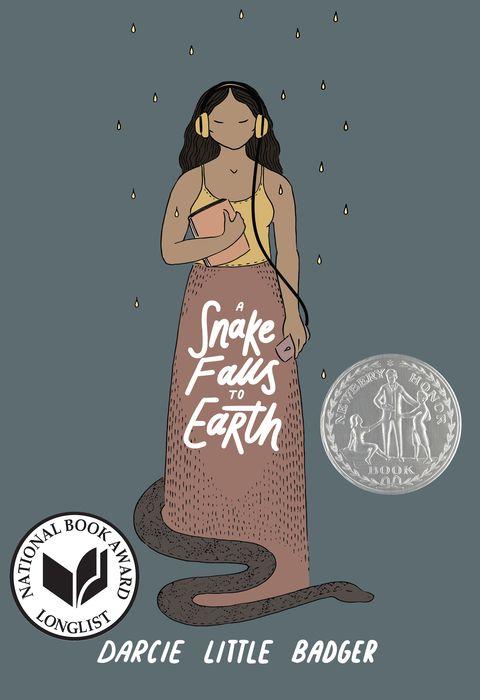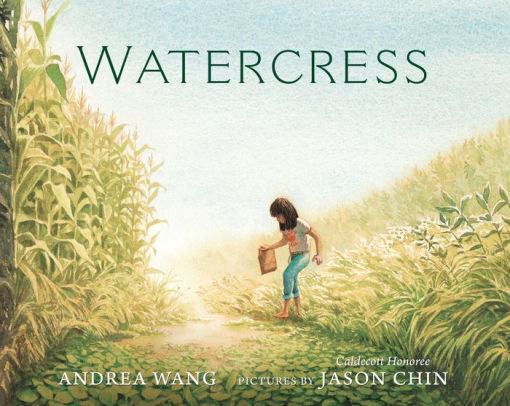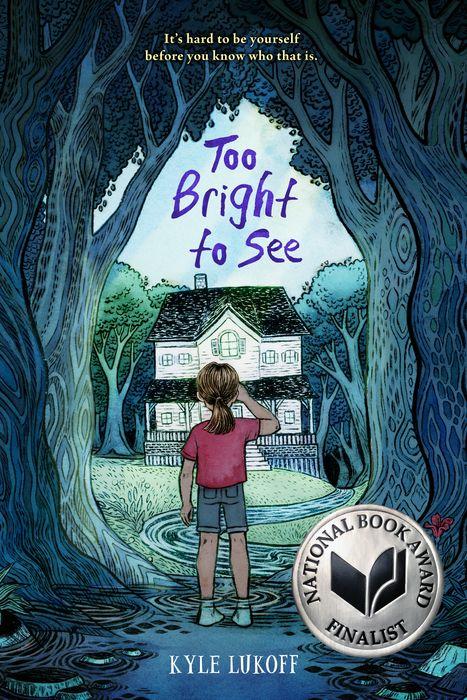In our continuing coverage of ALA Youth Media Award winners, we’re closing in on the big one: the Newbery!
Red, White, and Whole by Rajanni LaRocca. Quill Tree Books, 2021, 223 pages.
Reading Level: Ages 10-12
Recommended For: Ages 10-12 (and up!)

Reja straddles two worlds: her parents’ Indian world and her own (1980s) American world. One world exists at home, after school and on the weekends. The other is her world at school. Reja loves her mother’s Indian cooking, but she also loves 80s pop music. Her best friends include a fellow Indian expat (at “home”) and a Jewish girl (at school). Sometimes, Reja wishes she had one, unified world. Then one year, her two worlds collide and intersect. School projects require after school time at a non-Indian’s home. When a medical emergency hospitalizes Reja’s mother, both communities come together to support her.
Delicate and spare, this verse novel handles weighty topics with grace, courage, and honesty. Even when she’s complaining, in typical middle school fashion, Reja still honors her mother (and father), recognizing her mother’s love and sacrifice on her behalf. {spoiler alert} Reja’s mother doesn’t survive her medical emergency, but the gift of new life in another family member’s pregnancy helps foster the novel’s ultimately hopeful ending. Some considerations: the title refers partially to blood: red and white blood cells and imagery of blood (beginning with Reja’s own birth) are directly relevant to the plot, but may be too much for young sensitive readers. Additionally, Reja’s traditional Indian religious beliefs crop up here and there.
- Worldview/moral value: 4
- Artistic/literary value: 4
Awards: Newbery Honor Book, Walter Award Young Reader Category Winner
A Snake Falls to Earth by Darcie Little Badger. Levine Querido (Scholastic), 2021, 372 pages.

Reading Level: Middle Grades, ages 10-12
Recommended for: ages 12-15
Once upon a time, the two worlds were joined. Then a separation occurred, leaving Earth on one side and the reflecting world on another. On Earth, world shaping doesn’t happen, or if it does, they call it magic. One the other side, it’s a skill to be learned by animal people who can take human form at will (or mostly human—some tell-tale animal trait remains). But there are certain places, or passageways where animal people can cross over. One of those places, on Earth, is owned by Nina’s grandma, a Lipan (Apache) and the chief source for the legends Nina is recording on her phone.
On the other side of the great divide Oli, a young cottonmouth, has been making his own since leaving the next. A wrong turn in the woods made for a scary journey and a life-threatening monster attack, but he’s found a place to camp near a bottomless lake. And he’s found friends: Risk and Reign the coyote twins, Brightest the hawk—and Ami, the sweetest little toad there ever was. A crisis in Oli’s world and in Nina’s will bring them together, where together they’ll battle a threat from Earth and an equally deadly threat from beyond.
The author draws heavily on traditional Lipan tales for the animal people and two worlds. The story is told in a breezy and entertaining style, and tradition, community, and camaraderie save the day in a satisfying conclusion. Still, it seems too long; narrative drive is sometimes sacrificed for local color. As such, the climax lacks a certain punch; though we’re entertained, we’re not invested. This is a story about stories, like so much current literature, as if we’ve forgotten that stories are supposed to be about something else.
- Worldview/moral value: 3.5
- Artistic/literary value: 4
Considerations:
- Language: a few instances of vulgar words and one “my god.”
- Some gender ideology: Brightest the hawk is presented as nonbinary (pronouns they/them) and one of the animal legends features a same-sex couple. As if animals partook in the same gender confusion as . . . oh, well.
Award: Newbery Honor Book
Watercress by Andrea Yang, illustrated by Jason Chinn. Holiday House, 2021, 32 pages.

Reading level: Picture Book, ages 4-8
Recommended for: ages 6-10
“We are in the old Pontiac, the red paint faded by years of glinting Ohio sun, pelting rain, and biting snow.” A sullen girl stared out the back window, unmoved when the car abruptly brakes and both parents cry out, “Watercress!” The girl and her brother have to get out and dredge the icy creek for the “long stringy stems with leaves round as coins. It’s clearly a beloved childhood memory of China for her parents, but means nothing to the girl or her brother—just another weird custom in a new country where they’ve scrounged for furniture and cast-off clothes and hardly anyone looks like them.
But that evening, as their mother shares gray-tinged memories of China, where everyone dressed alike and there was seldom enough to eat, the girl comes to understand both the blessing of food and the power of memory. Jason Chinn’s luminous palette contrasts gray, barren China with hot, blooming Ohio, with gratitude the only proper response.
Awards: Newbery Honor Book, Caldecott Medal, Asian Pacific American Award. Previously reviewed in Redeemed Reader on June 1, 2021.
Too Bright to See by Kyle Lukoff. Dial (PRH), 2021, 186 pages
Reading Level: Middle Grades, ages 8-10
Recommended for: No One

Bug, age 11, is grieving the loss of her Uncle Roderick, who has been a father figure to her ever since her own father died. “Father figure” might not be quite accurate though; Uncle R is not only gay; he’s also a drag queen with a closet full of sparkly clothes and headdresses. Since his cancer diagnosis he’s quit the drag scene and has lived quietly with Bug and her mother in the centuries-old house in small-town Vermont. The house is haunted, a fact the whole family accepts. But with her uncle’s passing, one particular ghostly presence seems determined to break through to Bug from the afterlife. A series of vivid dreams leads her to realize it’s Uncle Roderick, and he’s trying to tell her something. It is about himself, or about her? Or . . . both?
The atmosphere of gloom that surrounds the opening chapters doesn’t quite lift. “Bug,” whose given name we never learn, spends most of the novel feeling alienated from others and herself, grieving, and sometimes frightened. Only after her uncle appears in the final dream and cuts her hair does she understand that she’s actually a boy. Her mother and her best friend accept this revelation with no hesitation, and Bug faces a confident future—with no concerns about top surgery, never-ending hormones, possible sterilization, or second thoughts later. Though better written, the story’s trajectory resembles that of George (now officially retitled Melissa), a happy conversion tale. “Be who you really are” is the theme, but the middle-grade readers this book targets don’t have a clue who they are, really or otherwise. Middle-grade is a time of trying on identities, but this is an identity with permanent consequences.
- Worldview/moral value: 2
- Artistic/literary value: 3.5
Read more about our ratings here.
We are participants in the Amazon LLC affiliate program; purchases you make through affiliate links like the one below may earn us a commission. Read more here.
Support our writers and help keep Redeemed Reader ad-free by joining the Redeemed Reader Fellowship.
Stay Up to Date!
Get the information you need to make wise choices about books for your children and teens.
Our weekly newsletter includes our latest reviews, related links from around the web, a featured book list, book trivia, and more. We never sell your information. You may unsubscribe at any time.
We'd love to hear from you!
Our comments are now limited to our members (both Silver and Golden Key). Members, you just need to log in with your normal log-in credentials!
Not a member yet? You can join the Silver Key ($2.99/month) for a free 2-week trial. Cancel at any time. Find out more about membership here.
2 Comments
Leave a Comment
You must be logged in to post a comment.


Using God’s name irreverently is important. I am glad you mentioned it. These books seem so superficial and not very edifying. I think we will pass.
Heather – We always try to note when God’s name is misused. Sometimes a book’s thematic elements will be outstanding enough to, not exactly overlook it, but pass over it, as unbelieving authors can still, by common grace, write something valuable and true. Sometimes the Name is used in a way that could be understood as a prayer. The Silver Arrow has received a lot of attention and has appeared on many “Best of” lists, and as such will probably be displayed on many library shelves. That’s why the review. The Popper Penguin Rescue has no objectionable content; it just wasn’t especially good.